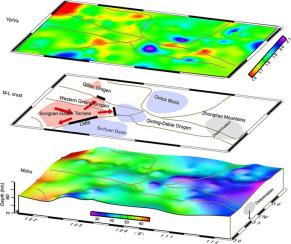当前位置:
X-MOL 学术
›
J. Asian Earth Sci.
›
论文详情
Our official English website, www.x-mol.net, welcomes your
feedback! (Note: you will need to create a separate account there.)
Crustal structure underneath central China across the Tibetan Plateau, the North China Craton, the South China Block and the Qinling-Dabie Orogen constrained by multifrequency receiver function and surface wave data
Journal of Asian Earth Sciences ( IF 2.7 ) Pub Date : 2020-10-01 , DOI: 10.1016/j.jseaes.2020.104535 Zigen Wei , Zhiwei Li , Ling Chen , Risheng Chu , Shanshan Wu , Yuan Ling , Qiu Zeng
Journal of Asian Earth Sciences ( IF 2.7 ) Pub Date : 2020-10-01 , DOI: 10.1016/j.jseaes.2020.104535 Zigen Wei , Zhiwei Li , Ling Chen , Risheng Chu , Shanshan Wu , Yuan Ling , Qiu Zeng

|
Abstract Investigating the crustal structure at the juncture region of the Tibetan Plateau, the North China Craton, the South China Block and the Qinling-Dabie Orogen is important to understand processes of uplift of the Tibetan Plateau and the craton destruction and preservation. In this study, we dropped the H-k stacking of receiver functions (RFs), RF nonlinear inversion, and joint inversion of RF and surface wave dispersion with multiple Gaussian factors successively to invert the crustal thickness (H), average Vp/Vs ratio (k) and S-wave velocity in the juncture region. The imaging results and the synthetic tests of multifrequency H-k stacking were further used to study the crustal structure and related tectonic evolution. Our results show that the H and k values generally increase and decrease, respectively, as the Gaussian factor increases in the study region, which is consistent with synthetic tests of H-k stacking. The cores of the Ordos Block and the Sichuan Basin exhibit a typical cratonic crust, whereas the Zhongtiao Mountains and adjacent Qinling-Dabie Orogen to the south may have undergone delamination of the lower crust. Local low-velocity anomalies in the middle-lower crust were observed in the Western Qinling Orogen and Qilian Orogen, whereas high S-wave velocities in the middle-lower crust were observed at the juncture region between the Western Qinling Orogen and the Qinling-Dabie Orogen. Our results suggest that the lower crustal flow is probably restricted to the central area in the Western Qinling Orogen and does not flow into the Qilian Orogen or the Qinling-Dabie Orogen.
中文翻译:

受多频接收函数和面波数据约束的青藏高原、华北克拉通、华南地块和秦岭-大别造山带地壳构造
摘要 研究青藏高原、华北克拉通、华南地块和秦岭-大别造山带交界区的地壳结构,对于了解青藏高原的隆升过程和克拉通的破坏与保存具有重要意义。在这项研究中,我们先后放弃了接收函数 (RFs) 的 Hk 叠加、RF 非线性反演、RF 和面波色散与多个高斯因子的联合反演,以反演地壳厚度 (H)、平均 Vp/Vs 比 (k ) 和交界区的 S 波速度。进一步利用多频Hk叠加成像结果和综合试验研究地壳结构及相关构造演化。我们的结果表明 H 和 k 值通常分别增加和减少,随着研究区域高斯因子的增加,这与 Hk 叠加的综合测试一致。鄂尔多斯地块和四川盆地的地核呈现出典型的克拉通地壳,而中条山脉和毗邻的秦岭-大别造山带南部可能发生了下地壳的拆离作用。在西秦岭造山带和祁连造山带观测到中下地壳局部低速异常,而在西秦岭造山带和秦岭-大别造山带交界处观测到中下地壳的高S波速度异常造山带。我们的研究结果表明,下地壳流可能仅限于西秦岭造山带的中心区域,而不流入祁连造山带或秦岭-大别造山带。这与 Hk 叠加的综合测试一致。鄂尔多斯地块和四川盆地的地核呈现出典型的克拉通地壳,而中条山脉和毗邻的秦岭-大别造山带南部可能发生了下地壳的拆离作用。在西秦岭造山带和祁连造山带观测到中下地壳局部低速异常,而在西秦岭造山带和秦岭-大别造山带交界处观测到中下地壳的高S波速度异常造山带。我们的研究结果表明,下地壳流可能仅限于西秦岭造山带的中心区域,而不流入祁连造山带或秦岭-大别造山带。这与 Hk 叠加的综合测试一致。鄂尔多斯地块和四川盆地的地核呈现出典型的克拉通地壳,而中条山脉和毗邻的秦岭-大别造山带南部可能经历了下地壳的拆离。在西秦岭造山带和祁连造山带观测到中下地壳局部低速异常,而在西秦岭造山带和秦岭-大别造山带交界处观测到中下地壳的高S波速度异常造山带。我们的研究结果表明,下地壳流可能仅限于西秦岭造山带的中心区域,不流入祁连造山带或秦岭-大别造山带。而中条山脉和邻近的秦岭-大别造山带南部可能经历了下地壳的拆离。西秦岭造山带和祁连造山带中下地壳局部低速异常,西秦岭造山带与秦岭-大别交界处中下地壳高S波速度异常造山带。我们的研究结果表明,下地壳流可能仅限于西秦岭造山带的中心区域,不流入祁连造山带或秦岭-大别造山带。而中条山脉和邻近的秦岭-大别造山带南部可能经历了下地壳的拆离。在西秦岭造山带和祁连造山带观测到中下地壳局部低速异常,而在西秦岭造山带和秦岭-大别造山带交界处观测到中下地壳的高S波速度异常造山带。我们的研究结果表明,下地壳流可能仅限于西秦岭造山带的中心区域,而不流入祁连造山带或秦岭-大别造山带。而在西秦岭造山带与秦岭-大别造山带的交界处,中下地壳的横波速度较高。我们的研究结果表明,下地壳流可能仅限于西秦岭造山带的中心区域,而不流入祁连造山带或秦岭-大别造山带。而在西秦岭造山带与秦岭-大别造山带的交界处,中下地壳的横波速度较高。我们的研究结果表明,下地壳流可能仅限于西秦岭造山带的中心区域,而不流入祁连造山带或秦岭-大别造山带。
更新日期:2020-10-01
中文翻译:

受多频接收函数和面波数据约束的青藏高原、华北克拉通、华南地块和秦岭-大别造山带地壳构造
摘要 研究青藏高原、华北克拉通、华南地块和秦岭-大别造山带交界区的地壳结构,对于了解青藏高原的隆升过程和克拉通的破坏与保存具有重要意义。在这项研究中,我们先后放弃了接收函数 (RFs) 的 Hk 叠加、RF 非线性反演、RF 和面波色散与多个高斯因子的联合反演,以反演地壳厚度 (H)、平均 Vp/Vs 比 (k ) 和交界区的 S 波速度。进一步利用多频Hk叠加成像结果和综合试验研究地壳结构及相关构造演化。我们的结果表明 H 和 k 值通常分别增加和减少,随着研究区域高斯因子的增加,这与 Hk 叠加的综合测试一致。鄂尔多斯地块和四川盆地的地核呈现出典型的克拉通地壳,而中条山脉和毗邻的秦岭-大别造山带南部可能发生了下地壳的拆离作用。在西秦岭造山带和祁连造山带观测到中下地壳局部低速异常,而在西秦岭造山带和秦岭-大别造山带交界处观测到中下地壳的高S波速度异常造山带。我们的研究结果表明,下地壳流可能仅限于西秦岭造山带的中心区域,而不流入祁连造山带或秦岭-大别造山带。这与 Hk 叠加的综合测试一致。鄂尔多斯地块和四川盆地的地核呈现出典型的克拉通地壳,而中条山脉和毗邻的秦岭-大别造山带南部可能发生了下地壳的拆离作用。在西秦岭造山带和祁连造山带观测到中下地壳局部低速异常,而在西秦岭造山带和秦岭-大别造山带交界处观测到中下地壳的高S波速度异常造山带。我们的研究结果表明,下地壳流可能仅限于西秦岭造山带的中心区域,而不流入祁连造山带或秦岭-大别造山带。这与 Hk 叠加的综合测试一致。鄂尔多斯地块和四川盆地的地核呈现出典型的克拉通地壳,而中条山脉和毗邻的秦岭-大别造山带南部可能经历了下地壳的拆离。在西秦岭造山带和祁连造山带观测到中下地壳局部低速异常,而在西秦岭造山带和秦岭-大别造山带交界处观测到中下地壳的高S波速度异常造山带。我们的研究结果表明,下地壳流可能仅限于西秦岭造山带的中心区域,不流入祁连造山带或秦岭-大别造山带。而中条山脉和邻近的秦岭-大别造山带南部可能经历了下地壳的拆离。西秦岭造山带和祁连造山带中下地壳局部低速异常,西秦岭造山带与秦岭-大别交界处中下地壳高S波速度异常造山带。我们的研究结果表明,下地壳流可能仅限于西秦岭造山带的中心区域,不流入祁连造山带或秦岭-大别造山带。而中条山脉和邻近的秦岭-大别造山带南部可能经历了下地壳的拆离。在西秦岭造山带和祁连造山带观测到中下地壳局部低速异常,而在西秦岭造山带和秦岭-大别造山带交界处观测到中下地壳的高S波速度异常造山带。我们的研究结果表明,下地壳流可能仅限于西秦岭造山带的中心区域,而不流入祁连造山带或秦岭-大别造山带。而在西秦岭造山带与秦岭-大别造山带的交界处,中下地壳的横波速度较高。我们的研究结果表明,下地壳流可能仅限于西秦岭造山带的中心区域,而不流入祁连造山带或秦岭-大别造山带。而在西秦岭造山带与秦岭-大别造山带的交界处,中下地壳的横波速度较高。我们的研究结果表明,下地壳流可能仅限于西秦岭造山带的中心区域,而不流入祁连造山带或秦岭-大别造山带。











































 京公网安备 11010802027423号
京公网安备 11010802027423号